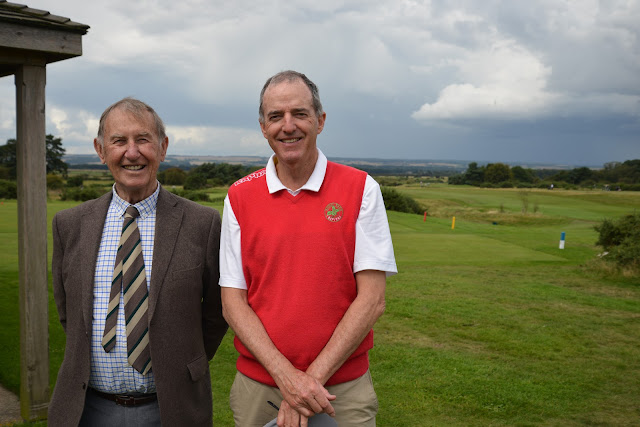Ganton Golf Club was the next stop on our tour, and again we were fortunate to be joined by the Ganton members. We were warmly greeted by member David Walker (who played KHGC earlier in the year) and received a clubhouse tour.
Not only is having a member host great for camaraderie between the two clubs, but it is vital in helping you know where to go. Apparently there is a fairway somewhere down there!
Ganton started life in 1891, as the Scarborough Golf Club, on it's current site which was part of Sir Charles Legard's Ganton Estate, having been laid out by Tom Chisholm from St. Andrews. The land, many years ago, was an inlet from the North Sea, so has a sandy subsoil that is perfect for a golf course. This gives the course a linksy feel, but with many heathland features as well.
The course was placed on the golfing map when club professional Harry Vardon, won the first of his six Open Championships at Muirfield in 1896. After leaving the club in 1903, Vardon combined with then club professional Ted Ray, James Braid and JH Taylor to perform a major redesign of the course in 1905.
Other architects including Harry Colt and Dr Alister MacKenzie have contributed to the Ganton that we see today. Apart from the deep bunkering, additional gorse was planted in the 1930's (by some cruel so and so), which has made it the strong challenge we see today.
In 1907 the Scarborough Golf Club became the Ganton Golf Club.
President of Ganton GC, Eric Bowles, with President of Kingston Heath, Geoffrey Knight.
The course requires length and accuracy, and does not give you much in the way of bail out areas. It is a really stern test, and one that would require quite a few rounds to get the hang of where to go and what to hit.
We had the heather in Surrey described as a bitch by the New Zealand Secretary. Well if the heather is a bitch, then the gorse is a motherf&%#$r. Thick and prickly, your ball is either lost or unplayable. Mostly lost.
The bunkers, like at Woodhall Spa are cavernous, and require great shots to negotiate past, and good skills to extract yourself from. That above, is one fairway bunker.
The bunker protecting the start of the fairway on the 16th. It is huge. Apparently it is big enough to fit two double decker buses in it. Oh, and if you manage to sneak past the sand, you could end up in a gorse bush in the bunker face. Wow!
The final four holes here are unbelievably difficult. Once you negotiate your way past the huge bunker on 16, you reach this, the 250 yard par three 17th. The driveway to the club runs across the hole, and is out of bounds.
I played with Ganton assistant professional Ollie today, not only a very good player, he was a lovely young man, and did his best to lead me around successfully. This, the 18th, has a blind tee shot, over a lot of gorse. This area was originally a sandy waste bunker called the Pandy, which was a working sand pit when the course first opened, and the staff can be seen in the picture reinstating this waste bunker.
A quality, yet brutal test of golf, that has had the distinction of hosting the 1949 Ryder Cup, 2000 Curtis Cup and 2003 Walker Cup. It can also boast that two of it's professionals, Harry Vardon and Ted Ray, have won the Open Championship and US Open. A very strong pedigree indeed.
Ganton and Kingston Heath members together after the round. Bernard Cassell won the individual prize with a fine 31 points. Only about 20 better than me!
Our next round is at another Ryder Cup venue, the Alister MacKenzie designed Moortown Golf Club in Leeds.















No comments:
Post a Comment